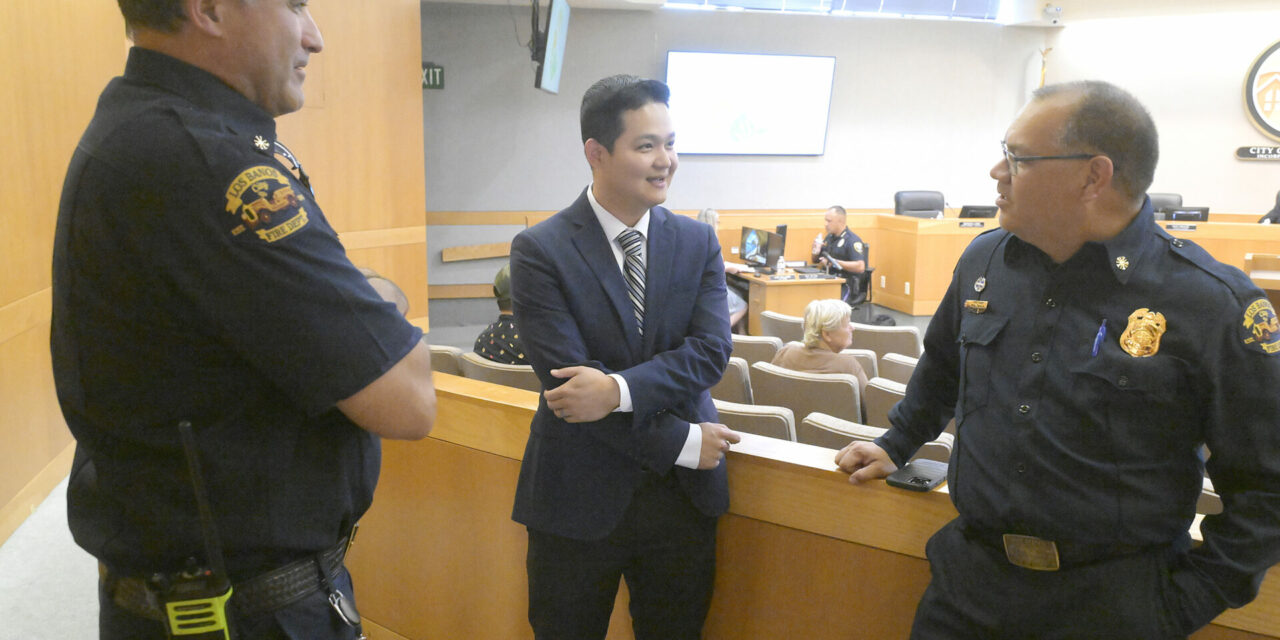The Los Banos City Council hired a new city manager at is Sept. 17 meeting and adopted an amendment to the mobile food vendor ordinance.
Mayor Micheal Amabile led a quorum of Mayor Pro-Tem Deborah Lewis and Councilmembers Evan Sanders and Marcus Chavez.
The District 1 council seat will be filled at the Oct. 1 meeting, according to Amabile. He reported that the certification process for the Aug. 26 election was accelerated by the county. The move was made “In order to accommodate the preparation for the statewide special election on Nov. 4,” Amabile read from a statement.
According to Amabile, out of 41 applicants for the position, the council chose Nirorn Than to be the next city manager. Than is the current city manager of Gustine and was the former Public Works Director and city Engineer in Los Banos. To finish projects in Gustine properly, he won’t officially start in Los Banos until November.
According to Interim City Manager Gary Brizzee, Than’s contract is for three years with two optional one-year extensions. His salary will be $238,000 “which is just under halfway through the city manager scale,” Brizzee said.
According to Amabile and Brizzee, the reason Than was selected was due to his experience, his great connection with staff, his familiarity with city projects and especially his care for the wellbeing of the city. “Bottom line is we need someone who cares about our city. We don’t want someone who just wants to do a job,” Amabile said.
“I stand before you,” Than said, “honored and humbled to come back home, to work for the community I live in. I’m very excited, so let’s build something that lasts, build something with purpose, and hopefully we can make all our residents proud to call Los Banos home.”
The amendment to the mobile food vendor ordinance was unanimously adopted on its final reading. The amendment as previously reported by The Express allows vendors to have temporary site furniture that was expressly prohibited in the old ordinance. It also allows the creation of “food truck parks.”
Mobile food vendor Ninive Gomez said, “Thank you, we have come a long way; thank you for taking the time and listening to us.” Community and Economic Development Director Stacy Elms told the council that the new amendment “benefits our community.”
The council also unanimously approved the suggestion of Finance Director Minnie Moreno to have a market rate study of city rental properties. This comes after Lewis requested that the city would have a better understanding of, “what our property is worth.”
Moreno will put out a request for proposals to begin the process.
At its Sept. 17 meeting, the council also:
— Interim Public Works Director Joe Heim gave the council two options of how to proceed with connecting Vineyard Drive to Mercey Springs Road. The first was a roundabout, and the second was a traffic light. Heim’s report focused on the benefits of roundabouts, from better safety statistics, cheaper construction, cheaper maintenance, and forcing slower speeds by design and traffic flow.
After Heim spoke, a representative from Caltrans was called up by Mayor Michael Amabile for a few questions. The representative highlighted the success of the Gustine roundabout handling tomato trucks on State Route 33.
Nirorn Than, selected by the council earlier in the meeting to be Los Banos’ next city manager, told the council that, as current city manager of Gustine, he had worked on the project. “We actually interviewed quite a few folks who spoke against it,” Than said, “and they’re actually really now very much for it.”
The Caltrans representative also highlighted that with rapid flashing beacons, high visibility sidewalks and lighting, pedestrian safety can be greatly improved.
Amabile asked if it would be possible to replace all stoplights on Pacheco Boulevard with roundabouts. The representative referenced the city of Carmel in Indiana, which did the same. “It’s much calmer and more friendly; people can walk, cross, bike.”
Councilmember Chavez asked for the opinion of the police and fire department chiefs on roundabouts. Police Chief Ray Reyna simply said, “Put them all down 152.” Fire Chief Paul Tualla said, “We would like to see the roundabout. Especially slowing traffic as it comes into town. We want to see increased traffic safety for both pedestrians and bicyclists.”
Mayor Pro Tem Lewis still had concerns over pedestrian and vehicular safety on a roundabout from distracted drivers and pedestrians.
The council voted 3-1 to go ahead with a roundabout, with Lewis voting no.
Amabile said that he wasn’t pro-roundabout at the beginning, but after looking over the reports, he’s been “won over.” “I think it is the future,” Amabile said.
— The council heard a presentation on the raising of San Luis Dam, also known as B. F. Sisk Dam. Pablo Arroyave, Chief Operating Officer of the San Luis and Delta-Mendota Water Authority reported that the entire project is expected to cost $1.044 Billion.
That cost is split between the Authority, the Bureau of Reclamation, and six partners. Those six partners are San Jose’s Valley Water, Westlands Water District, The City of Tracy, Byron Bethany Irrigation District, Patterson’s Del Puerto Water District, and San Benito Water District.
The project is three parts, the first being a safety expansion to increase the earthquake resistance of the dam, raising the crest by 10 feet without increasing capacity. “Sisk Dam is the largest ‘Safety of Dams’ project ever,” Arroyave said. The second is the raising of the Dam’s crest another 10 feet to increase water storage by 130,000 acre-feet of water storage. That is a 15 percent increase in water storage. And the third is the raising of less than a mile of State Route 152, 10 feet. Arroyave’s “aggressive schedules” show work starting in 2029 and a total completion of the project by mid-2031.
The part of SR152 in need of raising is the “rock bridge” that separates Cottonwood Bay from the main reservoir. Arroyave said that just this 2,000-foot stretch “is almost $500 million dollars of the project.”
Arroyave further elaborated that since the partners are paying for 70 percent of the project, they will get rights over 70 percent of the new water, with the other 30 percent being managed by the Bureau of Reclamation.




